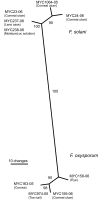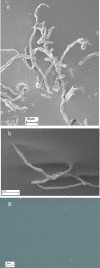Molecular characterization, biofilm analysis and experimental biofouling study of Fusarium isolates from recent cases of fungal keratitis in New York State
- PMID: 17263885
- PMCID: PMC1794232
- DOI: 10.1186/1471-2415-7-1
Molecular characterization, biofilm analysis and experimental biofouling study of Fusarium isolates from recent cases of fungal keratitis in New York State
Abstract
Background: To characterize Fusarium isolates from recent cases of fungal keratitis in contact lens wearers, and to investigate fungal association with MoistureLoc solution.
Methods: We studied six fungal isolates from recent cases of keratitis in New York State. The isolates were characterized by nucleotide sequencing and phylogenetic analyses of multiple genes, and then typed using minisatellite and microsatellite probes. Experimental fungal biofilm formation was tested by standard methods. MoistureLoc solutions were tested in biofouling studies for their efficacy in elimination of Fusarium contamination.
Results: Fusarium solani--corneal ulcers (2 isolates), lens case (1 isolate), and F. oxysporum--corneal ulcer (1 isolate), eye (1 isolate), were recovered from five patients. An opened bottle of MoistureLoc solution provided by a patient also yielded F. solani. Two distinct genotypes of F. solani as well as of F. oxysporum were present in the isolated strains. Remarkably, F. solani strains from the lens case and lens solution in one instance were similar, based on phylogenetic analyses and molecular typing. The solution isolate of F. solani formed biofilm on contact lenses in control conditions, but not when co-incubated with MoistureLoc solution. Both freshly opened and 3-month old MoistureLoc solutions effectively killed F. solani and F. oxysporum, when fungal contamination was simulated under recommended lens treatment regimen (4-hr). However, simulation of inappropriate use (15-60 min) led to the recovery of less than 1% of original inoculum of F. solani or F. oxysporum.
Conclusion: Temporary survival of F. solani and F. oxysporum in MoistureLoc suggested that improper lens cleaning regimen could be a possible contributing factor in recent infections.
Figures






Similar articles
-
Report on testing from an investigation of fusarium keratitis in contact lens wearers.Eye Contact Lens. 2006 Dec;32(6):256-61. doi: 10.1097/01.icl.0000245556.46738.14. Eye Contact Lens. 2006. PMID: 17099384
-
Growth and survival of Fusarium solani-F. oxysporum complex on stressed multipurpose contact lens care solution films on plastic surfaces in situ and in vitro.Cornea. 2006 Dec;25(10):1210-6. doi: 10.1097/ICO.0b013e31802dd3a4. Cornea. 2006. PMID: 17172900
-
Fusarium keratitis associated with ReNu with MoistureLoc sample kits.Eye Contact Lens. 2008 Nov;34(6):337-9. doi: 10.1097/ICL.0b013e31818c25bf. Eye Contact Lens. 2008. PMID: 18997545
-
Contact lens-related Fusarium infection: case series experience in New York City and review of fungal keratitis.Eye Contact Lens. 2007 Nov;33(6 Pt 1):322-8. doi: 10.1097/ICL.0b013e3180645d17. Eye Contact Lens. 2007. PMID: 17993829 Review.
-
Fusarium keratitis and contact lens wear: facts and speculations.Med Mycol. 2008 Aug;46(5):397-410. doi: 10.1080/13693780801961352. Epub 2008 Apr 4. Med Mycol. 2008. PMID: 18608899 Review.
Cited by
-
A murine model of contact lens-associated fusarium keratitis.Invest Ophthalmol Vis Sci. 2010 Mar;51(3):1511-6. doi: 10.1167/iovs.09-4237. Epub 2009 Oct 29. Invest Ophthalmol Vis Sci. 2010. PMID: 19875664 Free PMC article.
-
Assessment of genotyping markers in the molecular characterization of a population of clinical isolates of Fusarium in Colombia.Biomedica. 2022 Mar 1;42(1):18-30. doi: 10.7705/biomedica.5869. Biomedica. 2022. PMID: 35471167 Free PMC article.
-
Fungal keratitis: Mechanisms of infection and management strategies.Surv Ophthalmol. 2022 May-Jun;67(3):758-769. doi: 10.1016/j.survophthal.2021.08.002. Epub 2021 Aug 20. Surv Ophthalmol. 2022. PMID: 34425126 Free PMC article. Review.
-
Morphological and molecular characterizations of psychrophilic fungus Geomyces destructans from New York bats with White Nose Syndrome (WNS).PLoS One. 2010 May 24;5(5):e10783. doi: 10.1371/journal.pone.0010783. PLoS One. 2010. PMID: 20520731 Free PMC article.
-
[Health effects of indoor molds].Wien Med Wochenschr. 2007;157(19-20):462-5. doi: 10.1007/s10354-007-0459-x. Wien Med Wochenschr. 2007. PMID: 18030548 German.
References
-
- Rosa RH, Jr., Miller D, Alfonso EC. The changing spectrum of fungal keratitis in south Florida. Ophthalmology. 1994;101:1005–1013. - PubMed
MeSH terms
Substances
LinkOut - more resources
Full Text Sources
Medical

